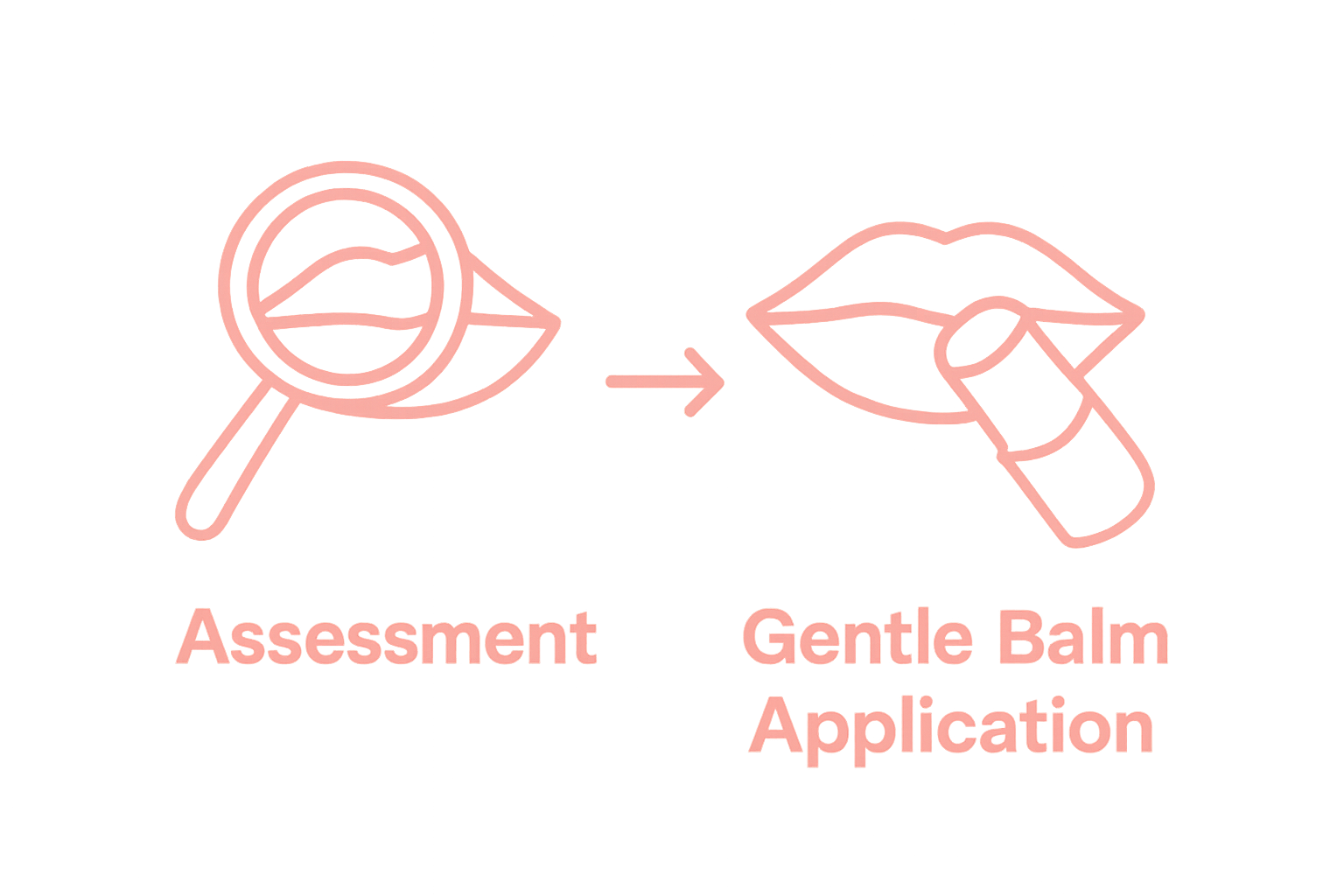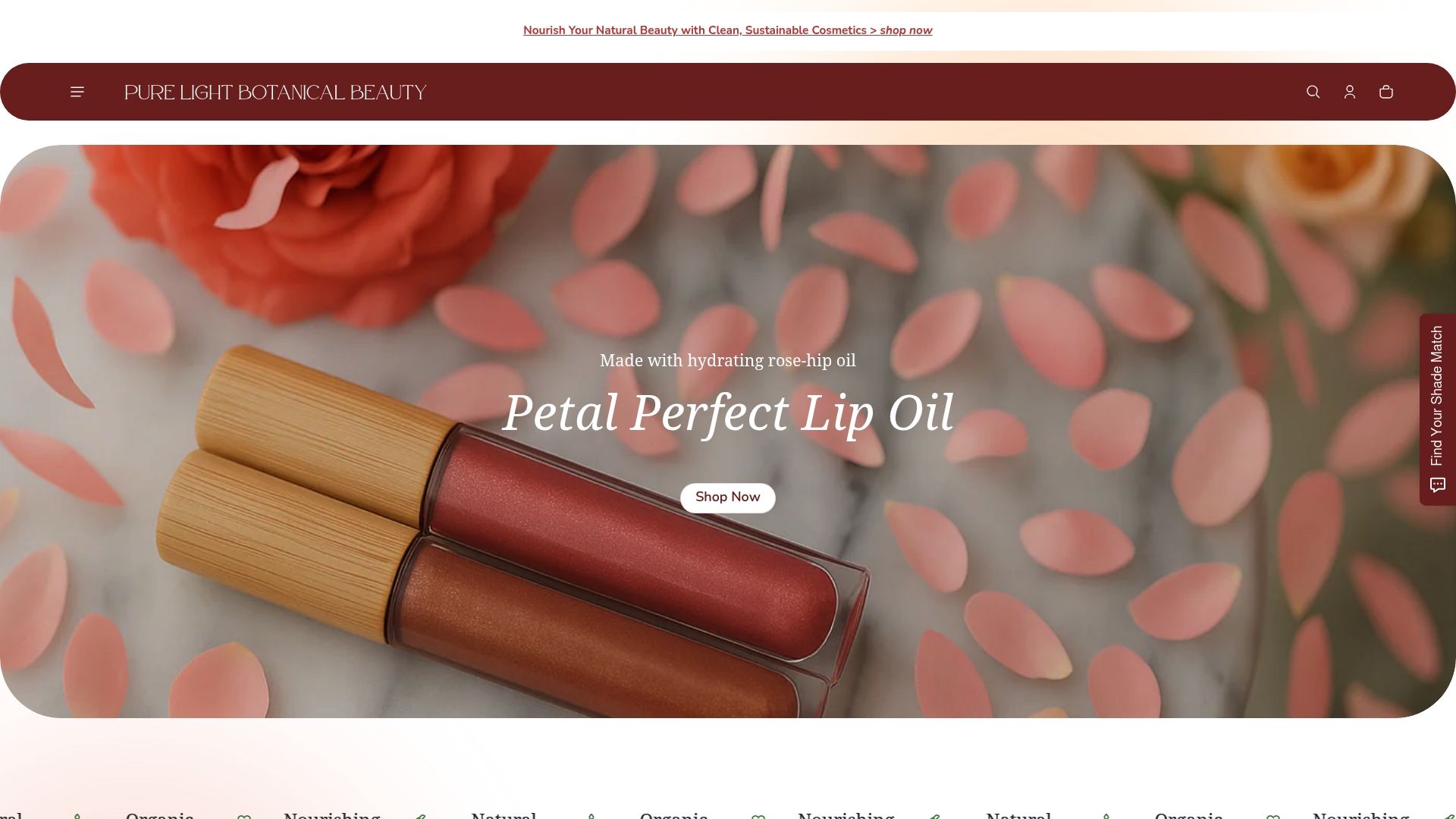Sensitive lips can turn every season into a survival game and finding real relief often feels impossible. Did you know that even so-called ‘gentle’ lip balms may actually worsen irritation for many people with delicate skin? Most people try product after product, expecting instant results, but real healing begins before you touch a single tube of balm. Forget everything you thought you knew about lip care because a custom, mindful approach is what truly soothes sensitive lips.
Table of Contents
- Step 1: Assess Your Lip Condition Carefully
- Step 2: Choose Gentle, Plant-Based Products
- Step 3: Cleanse and Exfoliate Your Lips Softly
- Step 4: Apply a Moisturizing Lip Balm Thoroughly
- Step 5: Shield Your Lips From Environmental Irritants
- Step 6: Monitor and Adjust Your Routine Regularly
Quick Summary
| Key Point | Explanation |
|---|---|
| 1. Assess your lip condition closely | Examine your lips in natural light to identify dryness, redness, or discomfort, which guides your care strategy. |
| 2. Choose gentle, plant-based products | Select lip care with natural ingredients like aloe vera and avoid synthetic components to prevent irritation. |
| 3. Cleanse and exfoliate softly | Use lukewarm water and gentle exfoliants to maintain moisture while removing dead skin without causing harm. |
| 4. Apply balm thoroughly and often | Use well-formulated lip balm with hydrating oils, and reapply regularly to keep your lips protected and nourished. |
| 5. Monitor and adjust your routine regularly | Keep a journal of lip conditions and adapt your care practices based on changes in sensitivity and environmental factors. |
Step 1: Assess Your Lip Condition Carefully
Addressing sensitive lip care requires a thoughtful and intentional approach that begins with understanding your unique lip landscape. Before diving into treatments or solutions, you need to carefully observe and assess the current state of your lips. Lip sensitivity isn’t a one-size-fits-all condition - it manifests differently for each individual, making personal observation crucial.
Start by examining your lips in natural light, using a clean mirror and taking a moment for honest self-reflection. Look for specific signs that indicate your lips need specialized care. Are they persistently dry with visible flaking? Do you experience a tight, uncomfortable sensation? Perhaps there are subtle redness or small cracks that suggest underlying sensitivity. These visual and tactile cues provide critical information about your lips’ health and will guide your subsequent care strategy.
Take time to gently touch your lips and note their texture. Sensitive lips often feel different from healthy lips - they might seem more fragile, react quickly to environmental changes, or show signs of distress more readily. Pay attention to how they respond to different conditions: Does cold weather cause immediate chapping? Do certain foods or products trigger irritation? Understanding these nuanced responses helps you create a personalized lip care ritual.
Documenting your observations can be immensely helpful. Consider keeping a simple journal tracking lip conditions, potential triggers, and changes over time. This approach transforms lip care from a reactive process to a proactive healing journey. Read our guide on holistic skin healing for deeper insights into understanding your skin’s unique language and needs.
Remember, assessing your lip condition isn’t about judgment but compassionate awareness. Your lips are communicating important information about your overall skin health, hydration levels, and potential sensitivities. By listening carefully and observing without criticism, you’re taking the first powerful step toward nurturing and transforming your lip wellness.
Below is an overview table summarizing the key steps for lip care for sensitive skin, including their purpose and main action.
| Step | Purpose | Main Action |
|---|---|---|
| Assess Lip Condition | Identify specific needs and sensitivities | Examine lips in natural light and note dryness, redness, or irritation |
| Choose Gentle Products | Prevent irritation and support healing | Select plant-based, minimal-ingredient products; avoid synthetic components |
| Cleanse & Exfoliate Softly | Remove dead skin without causing harm | Use lukewarm water, gentle botanicals, and ultra-soft exfoliants |
| Apply Moisturizing Balm | Restore hydration and protect lips | Choose balms with hydrating natural oils; apply thoroughly and regularly |
| Shield from Irritants | Prevent environmental damage | Use natural SPF or waxes, adapt to weather, and consider internal hydration |
| Monitor & Adjust | Maintain ongoing health and adapt to change | Keep a journal, assess lips weekly, and update the routine as needed |

Step 2: Choose Gentle, Plant-Based Products
Navigating the world of lip care products for sensitive skin requires a thoughtful and intentional approach that prioritizes natural, healing ingredients. Not all products are created equal, and when dealing with delicate lip skin, the selection process becomes crucial to preventing further irritation and supporting genuine healing.
Your journey toward finding the right lip care products begins with understanding the power of plant-based ingredients. Look for formulations that feature natural botanical extracts known for their soothing and regenerative properties. Ingredients like calendula, chamomile, rosehip oil, and aloe vera offer profound healing benefits without the harsh chemical interactions that can trigger sensitive skin reactions. Avoid products with synthetic fragrances, alcohol, and petroleum-based compounds which can strip your lips of their natural protective barrier and exacerbate existing sensitivities.
While scanning product labels, pay close attention to the ingredient list. Seek out products with minimal, recognizable components that read like a botanical garden inventory rather than a complex chemistry experiment. Discover our guide on selecting natural makeup for deeper insights into ingredient selection. Transparency matters - brands committed to skin health will openly share their ingredient sources and processing methods. Consider products that not only promise relief but demonstrate a holistic understanding of skin wellness.
Remember that choosing gentle, plant-based products is more than a purchasing decision - it’s an act of self-care and respect for your body’s natural healing mechanisms. Trust your intuition and be willing to experiment carefully. What works for one person might not work perfectly for another, so approach your product selection with patience and compassionate curiosity. Your lips are communicating their needs, and by listening carefully and selecting products that honor their sensitivity, you’re embarking on a transformative journey toward genuine lip health and radiance.
Step 3: Cleanse and Exfoliate Your Lips Softly
Cleansing and exfoliating sensitive lips requires an approach as delicate as the skin itself - a gentle ritual that respects your lips’ natural protective barrier while removing accumulated dead skin and environmental residue. Harsh techniques can cause more harm than healing, making mindful, soft methods essential for those with sensitive skin.
Begin your lip care ritual with lukewarm water and a soft, clean cloth or specialized gentle lip cleanser. Avoid hot water, which can strip natural oils and increase sensitivity. Use light, circular motions with minimal pressure, treating your lips like the fragile ecosystem they are. Natural plant-based cleansing agents work best - seek ingredients like chamomile, calendula, and aloe vera that provide cleansing without aggressive stripping. These botanical elements offer a nurturing touch that supports your lips’ inherent healing capacity.
Exfoliation for sensitive lips demands an ultra-gentle approach that feels more like a loving massage than an intense scrub. Create a homemade exfoliant using finely ground botanical ingredients like oatmeal, rice powder, or very fine sugar mixed with nourishing oils like jojoba or rosehip. Learn more about nourishing lipstick ingredients that can complement your lip care routine. Apply the mixture with fingertips using microscopically small, delicate motions - think of it as a whisper against your skin rather than a vigorous scrub. The goal is minimal physical intervention that encourages natural cell turnover without causing micro-tears or increased inflammation.
After exfoliation, always follow with a deeply hydrating, plant-based balm to restore moisture and reinforce your lips’ protective barrier. Your lips should feel soft, smooth, and calm - never raw or irritated. This gentle approach transforms exfoliation from a potentially damaging process into a nurturing, healing ritual that respects the unique sensitivity of your lip skin.
Step 4: Apply a Moisturizing Lip Balm Thoroughly
Moisturizing your sensitive lips is more than a simple skincare step - it’s a transformative healing ritual that rebuilds and protects your delicate lip barrier. Proper application requires intention and understanding, recognizing that each layer of balm is an opportunity to nourish and restore your lips’ natural resilience.
Begin by selecting a lip balm specifically formulated for sensitive skin, focusing on products with plant-based, deeply hydrating ingredients. Look for natural oils like jojoba, rosehip, and avocado that mimic your skin’s own protective mechanisms. Avoid petroleum-based products which might provide temporary relief but ultimately create a cycle of dependency without true healing. Instead, seek balms rich in botanical extracts that offer genuine nourishment and support your lips’ natural regenerative processes.
The application technique matters as much as the product itself. Warm the balm between your fingertips to help it melt slightly, allowing for smoother, more even distribution. Use gentle, sweeping motions that follow your natural lip line, ensuring complete coverage without excess pressure. Think of this as a mindful massage - each touch is an opportunity to increase circulation and support healing. Explore our collection of nourishing lipsticks for additional insights into lip care formulations that truly understand sensitive skin needs.
Pay special attention to the corners and edges of your lips, areas often overlooked but most prone to cracking and discomfort. Reapply throughout the day, especially before exposure to harsh environmental conditions like wind or cold temperatures. Your lips should feel consistently soft, supple, and protected - never dry or tight.
By approaching lip balm application as a nurturing ritual rather than a quick fix, you’re actively participating in your lips’ healing journey, transforming a simple skincare step into an act of profound self-care.
Step 5: Shield Your Lips from Environmental Irritants
Protecting sensitive lips from environmental challenges requires a proactive and holistic approach that goes beyond simple product application. Environmental factors can dramatically impact lip health, transforming your carefully cultivated lip care routine into a resilient defense mechanism against external stressors.
Consider your daily environment as a complex landscape of potential irritants. Wind, extreme temperatures, low humidity, and sun exposure can rapidly compromise your lips’ delicate protective barrier. Invest in high-quality, natural lip protection that creates a breathable shield without synthetic barriers. Look for products containing zinc oxide or plant-based waxes that offer natural sun protection and environmental defense. These ingredients work harmoniously with your skin, providing protection without blocking natural healing processes.
Your strategy should adapt dynamically to changing environmental conditions. In winter, when cold winds and indoor heating can devastate lip moisture, layer your protection more generously. During summer, prioritize lip balms with natural SPF ingredients to prevent sun damage and hyperpigmentation. Lightweight, botanical-based protectants work best, allowing your lips to breathe while maintaining a protective barrier. Discover our guide on choosing natural makeup for additional insights into holistic skin protection.
Beyond topical protection, consider internal strategies that support lip resilience. Stay hydrated, consume foods rich in omega-3 fatty acids, and use a humidifier in dry environments. Your lips reflect your overall wellness, and a comprehensive approach transforms environmental defense from a reactive measure into a proactive celebration of your skin’s natural strength and adaptability.
Here is a table outlining common environmental irritants, their potential impact on sensitive lips, and suggested protective actions based on the article content.
| Environmental Irritant | Potential Impact | Protective Action |
|---|---|---|
| Wind | Leads to rapid moisture loss and chapping | Apply natural wax-based balm and reapply during exposure |
| Cold Temperature | Causes cracking and increased sensitivity | Use thicker layers of balm and protect lips before going outdoors |
| Low Humidity | Dries out lips, making them more fragile | Use a humidifier indoors and hydrate frequently |
| Sun Exposure | Can cause sunburn and hyperpigmentation | Use balms with zinc oxide for natural sun protection |
| Indoor Heating | Reduces air moisture, worsening dryness | Increase balm use and maintain room humidity |
| Pollutants | May trigger irritation or inflammation | Shield lips with breathable, plant-based balms |
| Dietary Triggers | Can worsen sensitivity in certain individuals | Monitor reactions and adjust diet if necessary |
Step 6: Monitor and Adjust Your Routine Regularly
Maintaining a lip care routine for sensitive skin is not a static process but a dynamic, evolving journey of continuous observation and gentle adaptation. Your lips are living, changing landscapes that respond to internal and external shifts, requiring an attentive and compassionate approach to their ongoing care and healing.
Establish a weekly ritual of lip assessment, treating this time as a moment of connection with your body’s subtle signals. Examine your lips in natural light, noting texture, moisture levels, color variations, and any emerging sensitivities. Keep a simple journal documenting these observations, tracking how different environmental factors, dietary choices, and stress levels impact your lip health. This practice transforms lip care from a reactive treatment to a proactive, intuitive conversation with your body’s unique needs.
Remember that sensitivity is not a fixed state but a fluid experience influenced by numerous factors. Seasonal changes, hormonal fluctuations, stress levels, and dietary habits can dramatically alter your lips’ response to products and environmental conditions. Be prepared to modify your routine with grace and flexibility. Some weeks might require more intensive hydration, while others demand minimal intervention. Explore our guide on natural makeup selection to understand how holistic approaches can support your skin’s changing needs.
Approach routine adjustments with curiosity rather than frustration. If a product suddenly causes irritation or your lips feel different, it’s not a setback but an invitation to listen more closely. Your lip care routine should feel like a nurturing dialogue, not a rigid prescription. Embrace the understanding that healing is not linear - it’s a beautiful, meandering path of continuous discovery and gentle self-love.
Discover Real Lip Relief with Pure Light Botanical Beauty
If you have struggled with dryness, irritation or sensitivity on your lips, you are not alone. Many routines talk about gentle cleansing, plant-based ingredients and protective rituals, but making the right product choice can feel overwhelming when your lips are calling out for relief. Real healing starts when you switch to formulas designed to comfort, hydrate and protect sensitive skin at every step of your daily ritual.

Experience the differences our nourishing botanicals can make. At Pure Light Botanical Beauty, every ingredient is carefully chosen to soothe and restore even the most delicate skin, from our lip balms to our healing oils. Take the next step in your journey by exploring our curated guide to nourishing lipstick ingredients and discover ways to select natural makeup with true benefits. Now is the perfect moment to transform your lip care ritual into an act of real self-care. Visit us today and let your natural beauty shine.
Frequently Asked Questions
What should I look for in a lip balm for sensitive skin?
Choose a lip balm made with plant-based, deeply hydrating ingredients such as jojoba oil, rosehip oil, and avocado oil. Avoid petroleum-based products, as they can provide temporary relief without true healing.
How often should I exfoliate my lips?
For sensitive lips, exfoliate no more than once a week using a gentle method, such as a homemade scrub with finely ground ingredients like oatmeal or sugar mixed with nourishing oils. This soft approach helps remove dead skin without causing irritation.
How can I protect my lips from environmental irritants?
Use high-quality, natural lip protection containing ingredients like zinc oxide or plant-based waxes to shield your lips from wind, extreme temperatures, and UV rays. Adjust your lip care routine based on seasonal changes to maintain optimal hydration and protection.
Why is it important to assess my lip condition regularly?
Regular assessments help you understand how your lips respond to various factors, such as weather, diet, and products. Keeping a journal of your observations can guide you in adapting your lip care routine to best meet your lips’ needs.
